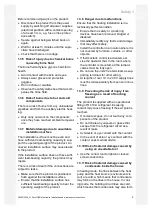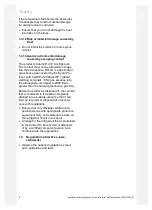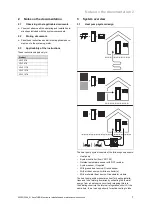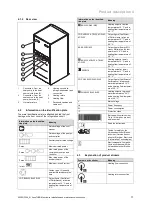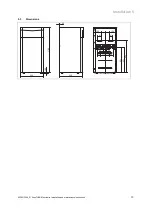
3 System overview
8
Installation and maintenance instructions flexoTHERM exclusive 0020213394_01
place via circulation reversal. The heat pump can be connec-
ted to three different types of heat source. This includes the
outdoor air, geothermal energy and groundwater, whereby
the heat source is connected to the heat pump via a transfer
station.
3.1.1
Heat pump
–
Fulfils the heating demand of the system controller down
to a minimum outside temperature and up to a maximum
target flow temperature.
–
Fulfils the cooling requirements of the system controller
up to a maximum source temperature.
–
Hot water generation with external domestic hot water
cylinder
3.1.2
Groundwater module
–
Heat transfer from the groundwater to the brine heat
transfer medium in the heat pump.
3.1.3
Air/brine collector
–
Heat transfer from the air to the brine heat transfer me-
dium in the heat pump.
3.1.4
Passive cooling module (optional)
–
When using ground or groundwater as a heat source,
the heat of the heating water is transferred to the heat
source medium purely using circulation pumps and valve
switching.
3.2
Functionality
3.2.1
Heat pump
2
3
1
4
5
6
7
8
9
10
11
12
13
1
Heating installation
2
Domestic hot water
cylinder (optional)
3
Heating circuit
4
Compressor
5
Refrigeration circuit
6
Brine circuit
7
Heat source
8
Brine pump
9
Evaporator
10
Electronic expansion
valve
11
Condenser
12
Heating/cylinder char-
ging diverter valve
13
Auxiliary electric heating
The heat pump system uses geothermal energy, outdoor air
or groundwater as the heat source.
The heat pump consists of the following separate circuits
which are coupled with one another by means of heat ex-
changers. These circuits are:
–
The brine circuit, which extracts the thermal energy from
the ground, the outdoor air or from the groundwater and
transfers this to the refrigeration circuit
–
The refrigerant circuit, which is used to bring the thermal
energy from the heat source to a usable, higher temper-
ature level and deliver it to the heating circuit
–
The heating circuit, which is used to heat up the living
rooms
The coolant circuit is connected via the evaporator to the
heat source, from which it extracts thermal energy. At the
same time, the physical state of the coolant changes; it
evaporates. The refrigerant circuit is connected via the
condenser to the heating installation, to which it releases the
thermal energy again. In so doing, the coolant becomes
liquid again; it condenses.





